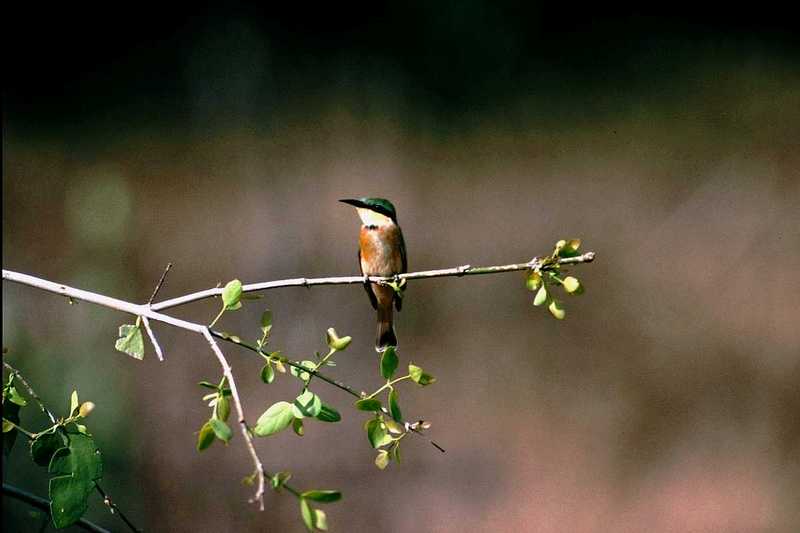|
| Query: Variegatus variegatus | Result: 69th of 93 | |
Identification needed for this bee-eater - aas50707.jpg (1/1)
| Subject: | Identification needed for this bee-eater - aas50707.jpg (1/1)
| | Poster: | Kim Jinsuk (jskim@bioinfo.kordic.re.kr)
| |

| File size : 63472 bytes
File date : 1999:01:21 09:00:00
Resolution: 1201x800
Jpeg process : Baseline
Posted Newsgroups: alt.binaries.pictures.animals
Posted Date: Wed, 20 Jan 1999 18:10:42 +0900 |
Identification needed for this bee-eater - aas50707.jpg (1/1)
--
From Broderbund ClickArt 200,000 CD
Private purpose only. Enjoy it.
Comments
========
From: pardosa@hotmail.com
Subject: Re: Identification needed for this bee-eater - aas50707.jpg (1/1)
Date: Wed, 20 Jan 1999 13:14:30 GMT
Most likely a Cinnamon-chested Bee-eater (Merops oreobates). Ranges from Sudan
to Ethiopia, Uganda, Kenya and northern and western Tanzania.
Could be confused with Merops variegatus, but the latter rarely perches in
trees.
Family: Meropidae
Order: Coraciiformes
source: J.G. WILLIAMS & N. ARLOTT, A Field Guide to the Birds of East Africa
Pardosa
Comments
========
From: groenhuys@riool.nl (Robert van Groenhuys)
Subject: Re: Identification needed for this bee-eater - aas50707.jpg (1/1)
Date: 20 Jan 1999 22:00:09 GMT
In article <36a5d173.1106768@news.online.be>, pardosa@hotmail.com says...
>
>Most likely a Cinnamon-chested Bee-eater (Merops oreobates). Ranges from Sudan
>to Ethiopia, Uganda, Kenya and northern and western Tanzania.
>Could be confused with Merops variegatus, but the latter rarely perches in
>trees.
>
>Family: Meropidae
>Order: Coraciiformes
>
>source: J.G. WILLIAMS & N. ARLOTT, A Field Guide to the Birds of East Africa
>
>Pardosa
I doubt very much if this is an oreobates. And I don't think it's a variegatus
either. All the evidence points to it being a Little Bee-eater (Melittophagus
pusillus), a species with which I have a lot of first-hand experience as a
field ornithologist in Africa. My first reaction on seeing this photo was: "a
Little Bee-eater!", and subsequent literature studies would seem to confirm it.
The following facts point to that conclusion:
- oreobates has a white patch on the side of the neck, below the black
eye-stripe. This bird shows no such patch.
- the bird gives the impression of being very small. Compare it to the branch
on which it's sitting; the branch appears to be very thin, leaves just budding.
oreobates is considerably larger and heavier than pusillus; variegatus is just
marginally larger.
- this bird is rather pale on the underside. Now, this may be an effect of worn
plumage, but in fact one of the different pusillus subspecies is noted for
having a pale underside. The other two species are usually rich black and
bluish on their breasts.
- pusillus is known for appearing singly or in small groups, and it is very
flycatcher-like in its behavior, liking to sit on a perch and make small forays
after passing insects. It's also a rather tame species which can easily be
approached for photography.
In my opinion this must surely be a Little Bee-eater (Melittophagus pusillus).
If not, the most likely candidate is the Blue-breasted Bee-eater (Melittophagus
variegatus). The Cinnamon-chested Bee-eater (Melittophagus oreobates) seems
quite unlikely.
/Robert
|
Comments |
|---|
| | Guest |
|
Scientific Name: Merops pusillus Müller, 1776
Common Names: English – Little Bee-eater, French – Guêpier nain
French: Guêpier nain German: Zwergspint Spanish: Abejaruco chico
Taxonomy: Merops pusillus Statius Müller, 1776, Senegal. |

|

|

|
Variegatus variegatus
69/93 |

|

|
^o^
Animal Pictures Archive for smart phones
^o^
|
|
|

